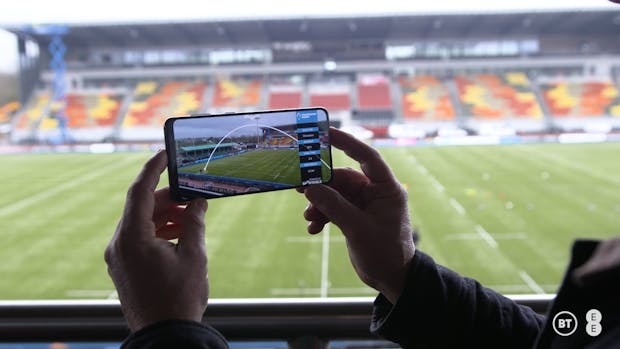
By their very nature, stadiums provide crowds with immersive experiences. But as fan habits change, and technologies develop, there’s more that could be done to create future-proof stadiums.
This is an evolution that is already happening overseas. In the US, for example, multiple stadiums and arenas have been outfitted with the latest smart technology, designed to bring fans closer to the action. While this is yet to become commonplace in the UK there are some notable examples, specifically StoneX Stadium, the home of Saracens rugby in London. In a project supported by The Department for Science, Innovation and Technology as part of 5G Create, an initiative that aims to explore and develop 5G technical capabilities and use-cases, BT recently unveiled new ways to watch or experience sports and performing arts.

Utilising the 5G Create technology unveiled at the StoneX Stadium, AR prototypes and everyday devices such as smartphones, tablets and TVs enable sports fans to get up close and personal with boxers, bringing fight nights into their living rooms for example, as they fight with highly immersive holographic videos. Rugby fans can take their in-stadium match day experience to the next level with more in-depth game analytics, commentary, and even multiple camera angles for a better view of the action, all available through their smartphones, tablets or AR headsets.
The result? An enhanced fan experience within stadiums, reimagining their venue interaction from ticket purchase, and more ways to engage with audiences outside of them with post-event data handling.
But the introduction of smart technology doesn’t only benefit fans; the venues themselves will see improved crowd safety measures, smart sustainability initiatives, and more opportunities to generate additional value – even on non-event days.
Attracting a crowd: Addressing changing fan habits
The first generation of so-called ‘digital natives’ has arrived, and Gen Z’s unique expectations are driving transformation across sectors.
Within the sport and entertainment industry it’s particularly notable that young fans engage in different ways to their predecessors. Significantly, 70 per cent of Gen Z fans are seen as more casual, less avid fans than older generations, with an even higher percentage of them choosing to stream sports online. That’s a huge increase compared to Boomers, where less than half (46 per cent) consume content in this way.
To attract a younger audience to physical events, venues need to provide experiences that offer something innovative and exciting. This is supported by research from Oracle, which shows that 64 per cent of sports fans think it would be amazing to engage with their favourite teams in the metaverse. The introduction of smart technologies like social media integration and in-game experiences could be the answer. It brings with it multiple connectivity benefits, including more comprehensive audience data which can be used to tailor sponsorships, communications, and marketing.
During the match: Enhancing the fan experience through connectivity
Whether hosting a sporting event or a concert, it is the role of venues to provide escapism. With smart connectivity, venues can maximise that escapism to a huge degree, providing solutions which support and enhance the fan experience.
Immersive spaces could soon see VIP ticket holders create digital projection rooms for unforgettable experiences, allowing them to interact with notable figures like the captain of a winning team, from their boxes. And while these are relatively advanced examples of what the technology could offer, the introduction of smart facilities management would mean a more seamless venue experience for all fans.
Ask any fan – or indeed any facility manager – to name the biggest drawback of in-person event attendance, and it’s likely they’d name the time spent standing in queues. Smart stadiums could drastically reduce, if not completely eradicate, this frustration.
Utilising computer vision artificial intelligence (AI) and BT’s Digital Vision offering, in partnership with Atos, into digital signage or apps throughout the venue would reduce fan wait-times, while at-seat ordering and frictionless concession solutions would improve purchase efficiency. Crowd safety is also supported with Digital Vision, enabling stadiums to monitor crowd levels and ensure the right number of staff are at hand to support fans.
On-the-day upgrades, too, would allow fans to choose better seats, if available, from their phones once already inside, maximising revenue for smart venues with upselling and cross-selling opportunities in line with demand. This can be pursued at multiple levels, including online voting systems for new menu items making fans feel more involved and more likely to return.
In this way, smart venues would respond to fans’ needs, providing an enhanced experience from entry. That same AI deployment also means stadiums would benefit from more robust safety measures. Fires could be detected and addressed before becoming a major issue. Biometric ticketing would better protect fans from ticket fraud, as well as improving the efficiency of venue entry as busy areas and congestion points can easily be identified – and dispersed – at speed.
Hosting events in a sustainable way is also important, so through Internet of Things (IoT) and increased connectivity, smart venues can also focus on accurately delivering the required levels of lighting and heating, and digitally handle maintenance across thousands of waste bins and hundreds of toilet facilities. Monitoring these facilities creates a more seamless fan experience, as temperatures can be optimised and facilities can be efficiently serviced when they’ve reached the level of usage required, contributing to venue sustainability targets as well as creating the best fan experience.
After the game: Creating additional value
Venues and stadiums are in competition with each other to attract events, be that for music concerts, boxing matches or one-off sporting events such as American football. To attract fans, venues need to demonstrate they are safe and secure, while providing an unrivalled experience. Looking at how emerging technology is supported by a robust and powerful 5G network is vital.
Comprehensive audience data also plays a huge part in providing a tailored solution for each event. A better understanding of customers and their habits means increasingly targeted and successful commercial sponsorship opportunities. We are working with stadiums to maximise and monetize the data they collect. This could be customisable offers to entice fans to future events, for example, or targeting corporate partnerships and sponsorship opportunities for the right audiences.
By continually evolving the technology utilised at a venue, such as high-speed connectivity, we can help improve the fan experience from sofa to seat and give audiences the best experience possible on the day. It also enables venues to remain competitive to host a wide range of events.
The final score: Maximising our venues
To attract generations of younger fans, it’s vital for stadiums to evolve. From on-the-day experiences to post-game involvement, smart technologies are uniquely positioned to help drive better, more immersive fan interactions, all while improving the safety and security of stadiums.
The advent of smart stadiums is reliant on robust connectivity which has the capacity to provide higher bandwidth and offer immediate access. AI, connected devices and Augmented Reality (AR) technologies must be underpinned by strong networks.
With BT’s focus on 5G communications, delivering new opportunities around IoT, AR, AI and Digital Vision, paired with its fantastic capabilities through BT Media and Broadcast, it is uniquely placed in the UK to deliver what a smart stadium needs now and into the future. We’re able to offer unrivalled, whole-experience connectivity, with a range of commercially available products. Through BT Media and Broadcast’s smart broadcast network Vena, we provide an outside broadcast and media exchange platform to over 140 fibre-connected venues, and this allows content to be distributed globally.
5G private networks, alongside satellite, also enables broadcast connectivity from virtually anywhere, for a multitude of purposes. These can include connecting the cameras and the production facilities on site in a simpler, more efficient way than traditional wireless radio technology. Or, if it is a smaller or more remote venue that doesn’t have fibre connectivity, private 5G can be used instead of satellite to send the camera feeds back to the studio.
The untapped potential within smart technologies could revolutionise the stadium experience – for fans, and for the venues themselves. With a range of options already available, it’s time for stadiums to advance their offering, drive their business case forwards, and bring fans seamless escapism.